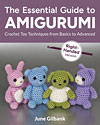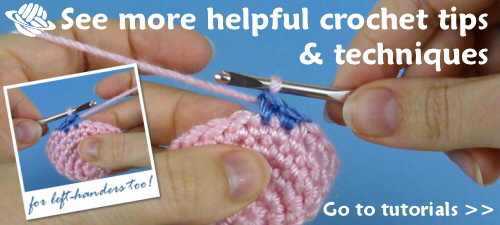This is the final post in my three-part series aimed predominantly at crocheters outside North America. For the rest of the series, see Yarn for Amigurumi and Crochet Hook Styles.
Non-Standardised Terminology
The names of the crochet stitches are, unfortunately, not standardised throughout the English-speaking world. Most crochet patterns you’ll find through online sources are written in US terminology (which is why I call this ‘standard’ terminology) – but if you buy/use a pattern written or published in UK/Aus, that may not be the case.
Conversely, if you learnt crochet from a British or Australian source, or some other countries with a historical British influence, you probably know the UK terminology. Your ‘double crochet’, for example, refers to a different stitch (US single crochet) than a US double crochet (which is equivalent to your ‘treble crochet’) – confusing, huh?
Note: If you’re not sure which terminology you use, look at my single crochet tutorial: right-handed or left-handed. If you know this stitch as a ‘double crochet’, you’re using UK terminology!
US/UK Conversion Table
Here are the most common stitches with their equivalent US and UK names:
| US Stitch Name | UK Stitch Name |
| chain | chain |
| double crochet | treble crochet |
| half double crochet | half treble crochet |
| slip stitch | slip stitch |
| single crochet | double crochet |
| triple (or treble) crochet | double treble crochet |
The basic rule is that the UK stitches are always named one step higher than their US counterparts.
Converting Amigurumi Patterns
Amigurumi patterns aren’t too difficult to decipher, as they are (almost) always worked in (almost) all single crochet stitches (i.e. ‘double crochet’ stitches in UK terminology), so it’s very easy to convert these patterns between US/UK. Using the above table, you’ll see that chain and slip stitch are unchanged, so it’s just the single/double crochets you may need to change to convert to your preferred terminology.
Note: All PlanetJune patterns – amigurumi and accessories – are written in standard (US) terminology, but, to prevent confusion, my patterns always also include a conversion table at the start for all stitches used, so you can look up the pattern abbreviations and see which stitch should be used, whichever terminology you’re used to.
Terminology Tips
- There is no stitch known as ‘single crochet’ anywhere in UK terminology, so, if you see any pattern that uses ‘sc’ stitches, you know it’s a standard/US pattern. UK/Aus: work a dc in place of every sc, and convert all other stitches.
- If you see an amigurumi pattern worked in ‘dc’ stitches, but the stitches look like those of a regular amigurumi, it’s almost certainly a UK pattern and you should work a US single crochet everywhere the pattern calls for a double crochet. UK/Aus: work the pattern as written.
- If in doubt when you use an indie pattern that doesn’t have a terminology table to clarify the stitches, check with the pattern designer.
- A pattern in a book or magazine will almost always use the terminology of the publication’s country of origin, but you can check the description of the stitches used (usually at the start or end of the book/magazine) to make sure.
It’s very unfortunate that when you find a crochet pattern that calls for, for example, a ‘double crochet’ stitch, that may mean one of two different stitches depending on where the pattern was published (or which terminology the designer/publisher decides to use), but I hope this post will help to clear up the confusion!
Loved this tutorial? I have so many more amigurumi tips and tricks to share with you!
Boost your amigurumi skills with my latest book, The Essential Guide to Amigurumi, your comprehensive guide to amigurumi techniques and tips.
Do you find my tutorials helpful? If so, please consider making a contribution towards my time so I can continue to create clear and concise tutorials for you:
Thank you so much for your support! Now click below for loads more crochet video and photo tutorials (and do let me know what else you’d like me to cover in future tutorials…)


















Karen Richardson said
I just wanted to say, what a breath of fresh air your tutorials are 🙂 I am a complete novice in Amigurumi and sooooo want to learn, but looking at many tutorials for how to make ie, the magic circle, I found I just couldn’t get it? BUT, then I found your site and Tada! I followed your video tutorial and managed to do it first time! I was totally amazed. Your tutorials are very easy and simply explained which I love. I can’t wait to produce my first Amigurumi cutie! there are quite literally hundreds I would love to make. When I get more proficient, I then want to try making teeny tiny Amigurumi, which is my ultimate aim.
Thank you so much for providing something I can actually follow!
Good luck with all that you do
Karen x
Cheryl-anne Marie Clark said
I don’t mind converting the terminology into UK/Aust from American, I only with that the pattern would state what terminology is used in it at the start.
Cheryl.
kbsalazar said
Yup. This is a persisting problem. I blogged about it more than 10 years ago, and it’s only gotten worse: string-or-nothing.com/2004/09/22/terminology-in-crochet/
Thanks for helping to get the word out, to clear up the general confusion. -K.
Richard Rose said
And this is why my patterns specify that I use UK/Aus terminology right at the start. 🙂